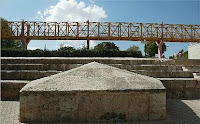The
district Velluters is
are
my favorite one around
Valenciawith the Market and
Carmen, since
I was born there
and moved along those narrow
streets during my
childhood.

It is also the damagest due to successive enlargements of the city and further degradation of the streets because of some remain of the ancient "brothel".
Velluters is a neighborhood that is named the "Mercers" and Silk trade workers since they had many factories from the sixteenth to the eigthenth centuries, with a good presence of Genoese craftsmen. Proof of that, the image of the Virgin of the Helpless that this group built in an altar to the Church of St. Augustine. This church has conserved proudly the oldest image of devotion of Valencia, Our Lady of Grace. Other religious monuments are the church of St. Charles Borromeo, due too to this very brotherhood of the Genoese, next to the old general hospital and the academy of surgery, the Pilar Church, run by the Dominican fathers.

It is also the damagest due to successive enlargements of the city and further degradation of the streets because of some remain of the ancient "brothel".
Velluters is a neighborhood that is named the "Mercers" and Silk trade workers since they had many factories from the sixteenth to the eigthenth centuries, with a good presence of Genoese craftsmen. Proof of that, the image of the Virgin of the Helpless that this group built in an altar to the Church of St. Augustine. This church has conserved proudly the oldest image of devotion of Valencia, Our Lady of Grace. Other religious monuments are the church of St. Charles Borromeo, due too to this very brotherhood of the Genoese, next to the old general hospital and the academy of surgery, the Pilar Church, run by the Dominican fathers.
Among the civil architecture
of the district stood once
the old Provincial Hospital of Valencia, together with the Faculty of
Medicine, demolished in the pasts
60s of the
last century. Today has it
been restored
into a space
for the
Muvim museum of the
Illustration with interesting temporary exhibitions of art and
ethnography. And the hospital cruise became
a Municipal Library, the Library of the
Hospital with an
interesting interior.
The new
gardens of orange and palm
tress have been recently
opened and is a gathering of young bohemian of
this district, the “Gothic
area”, and socializing of
people accompanying a huge
variety of dogs.
The palace of the silk Arts&Crafts is the next interesting building, unfortunately, as our newspapers write without a definite project for restoration. And thing most remarkable when you can not understand without this institution the main monument of our Middle Age heritage such as The Silk Exchange Market or the Lonja. The third important building of this area is the Palace Tamarit, from an interesting family of farmers from Ruzafa, which derived their agricultural efforts in investment into the lucrative silk looms.

The palace of the silk Arts&Crafts is the next interesting building, unfortunately, as our newspapers write without a definite project for restoration. And thing most remarkable when you can not understand without this institution the main monument of our Middle Age heritage such as The Silk Exchange Market or the Lonja. The third important building of this area is the Palace Tamarit, from an interesting family of farmers from Ruzafa, which derived their agricultural efforts in investment into the lucrative silk looms.

Entrance Silk ARst&Crafts Palace
In
this environment also stands The
School of Arts
and Crafts
and several traditional Valencianl
dressing companies, as
Albaes, who
pioneered the design both artisanal and industrial of
silk clothing of
Valencia, whose main
exponent focuses on
Spring feasts of St. Joseph, known worldwide as Las Fallas.
Are
you encouraged for this
route?
JVN
Know more about:
Juan-Luis Corbin Ferrer, Barrio del Pilar, antiguo de Velluters, Valencia 1991
Joan Boronat-Josep vicent Boira-Ricardo Franch, El Palau Tamarit, Valencia 2011.
See and Visit
















